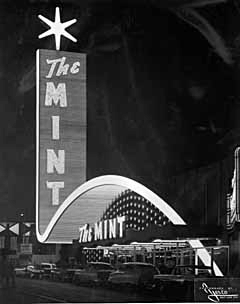
By now most of you know that our favorite book on Las Vegas Architecture is Alan Hess's
"Viva Las Vegas: After Hours Architecture" but it's not the only one. "Learning From Las Vegas" was published over thirty years ago and a group of architecture students are descending upon the Strip to see what has changed since the book was published in the early 1970s.
Joe Brown writes in the Las Vegas Sun:
“Less is a bore,” proclaimed the little book about Las Vegas architecture.
When it was first published nearly 40 years ago, “Learning From Las Vegas” was called “an assault,” “a dangerous book.” Lauding the city’s “messy vitality,” it put Vegas on the architectural map and generated a healthy controversy, calling for architects to be less elitist and more receptive to the unself-conscious tastes and values of ordinary people, reversing the modernist decree that “less is more.”
The authors were architects Robert Venturi and Denise Scott Brown, Venturi’s wife and partner, and Steven Izenour, now deceased, writing when Las Vegas was well on its way to becoming the architectural marvel — or monstrosity — it is today.
It’s time for a new look at Las Vegas.
Next week 10 Yale University architecture students, led by Washington, D.C.-based architect David M. Schwarz, will fly in to study the Strip’s shopping areas and entertainment centers. Schwarz, who is designing the $360 million Smith Center for the Performing Arts for Las Vegas’ downtown, is calling the study “Learning in Las Vegas.” The intent is to produce another significant book on the Strip. Schwarz has been contracted by Harrah’s to master plan its Strip properties and, not coincidentally, the Yale group will use Harrah’s mile on Las Vegas Boulevard as its study case — the problem of Las Vegas.
In an architectural design studio, Schwarz says, “you give the students a problem, and they design to solve the problem. It’s pretending you are the client and they are the architect. Our design problem is for a piece of the Strip. But we’re going to spend a lot of time looking at downtown to understand the origins of Las Vegas’ architectural pattern.”
In their 1972 book, Venturi and Scott Brown summarized the 1968 research study of the Las Vegas Strip they taught at Yale’s School of Architecture and Planning. Architects and students analyzed Vegas’ unique uses of signage, space, lighting, transportation and building design to communicate and promote.
“Learning From Las Vegas” was controversial on arrival, and remains influential — it is still discussed and debated.
“It inverts the ideas that many have based their professional lives upon,” The Ohio Review said about it at the time. “It threatens those things that we use to distinguish the distance between us, the cultured, and them, the vulgar. It is difficult to accept the idea of the citizens of our ‘know-nothing culture’ knowing more about the world they live in than the trained cultural architect and their insolence in preferring it.”
The architects/authors coined the terms “duck” and “decorated shed,” concepts still used by architects.
“Ducks” are literalism in advertising, buildings whose shapes are meant to communicate the activity going on inside (named after a Long Island roadside poultry shop shaped like a duck). Think of buildings shaped like hot dogs, pyramids and cityscapes.
“Decorated sheds” are mundane structures — casinos, hotels, restaurants — with large-scale decorations, text or obvious symbols to tell a quickly moving passer-by what’s within an otherwise bland big box. Think of just about any casino-resort not among the ducks.
In the decades since Venturi and Scott Brown were here, the desert city has continued to sprawl and erupt horizontally and vertically. The gambling mecca now derives most of its revenue from nongaming ventures — shopping, dining, entertainment. There are pyramids and castles, towering electronic displays, simulacrums of Paris and Venice and New York.
“I think that book really did capture one aspect of the American-built environment,” Schwarz says. “But I don’t think it’s sufficiently judgmental. I think that many Strip centers have been built under the guise of decorated sheds. And the book doesn’t talk about having sufficient responsibility in what we build, how we build and how we make place.”
What Venturi and Scott Brown did, Schwarz says, was take a look at Las Vegas and ask, “What does the rest of the world have to learn from what’s happened in Las Vegas?”
“It occurred to me that the rest of the world has changed a lot — as has Las Vegas — in the last 40 years,” says Schwarz, who is the Davenport visiting professor at Yale. “And that it would be very interesting to take a look at what Las Vegas ought to be learning from the rest of the world. And how you would convert the past 40 years of Las Vegas, knowing what we know now from the rest of the world, into the Las Vegas of the future.”
Schwarz says he expects many fascinating questions to arise. For starters: Should open areas on the Strip be developed and how should infill projects be built? How do you facilitate pedestrian-friendly streets? What is the role of adaptive reuse, and these days, when we’re much more concerned about sustainability, is it wasteful to keep tearing buildings down and building new ones? And how does all of this fit into the ethos of the 21st century?
“There are a gazillion experts on this,” says Schwarz, noting that students will meet with Boyd Gaming kingpin Bill Boyd, MGM Mirage’s Alan Feldman, and Harrah’s chief executive, Gary Loveman, and vice chairman, Charles Atwood, who will give a talk called “Follow the Money: Sex, Greed and Architecture in Las Vegas.” Students will visit Venturi and Scott Brown in Philadelphia.
And, of course, they’ll see the Cher and Cirque shows.